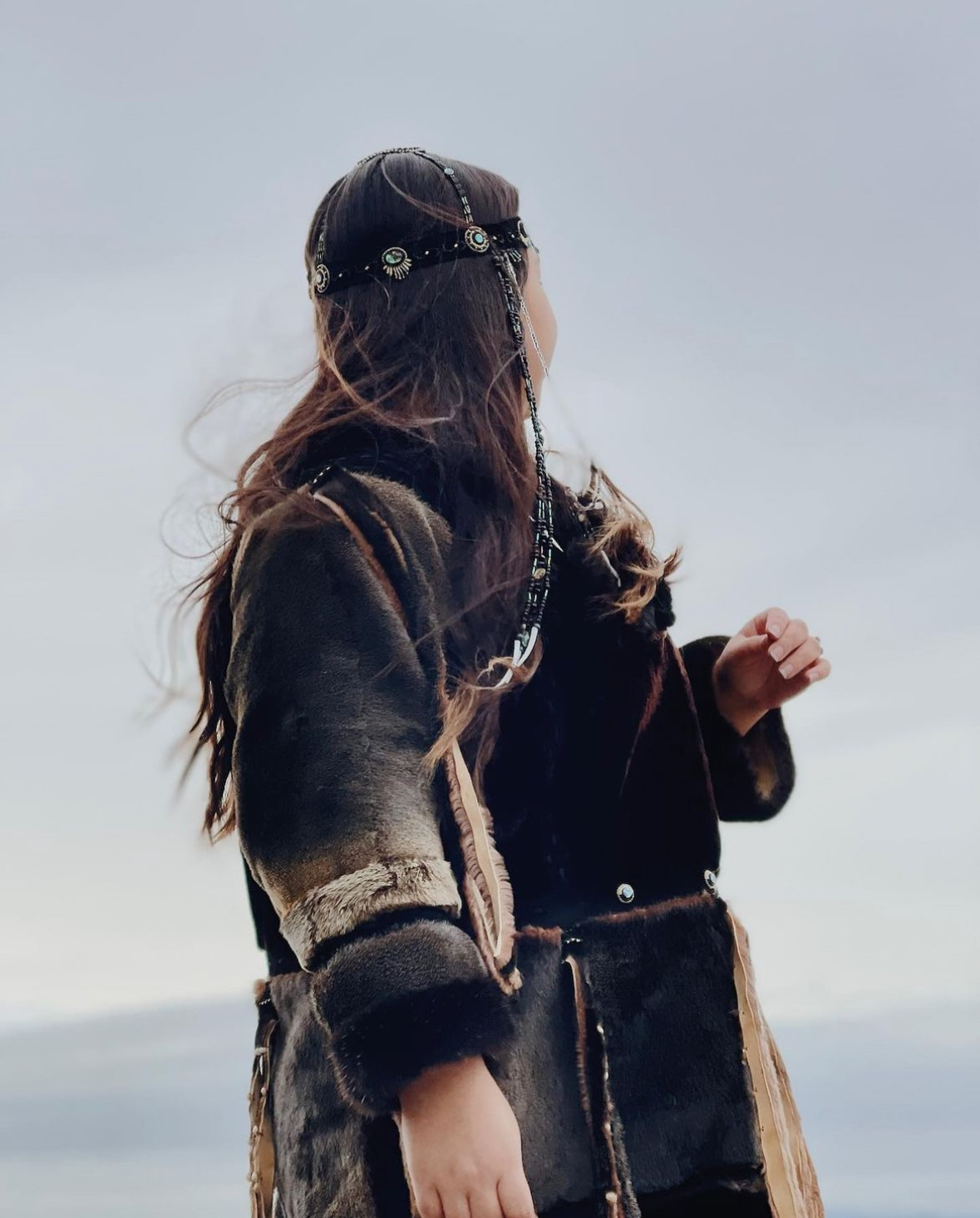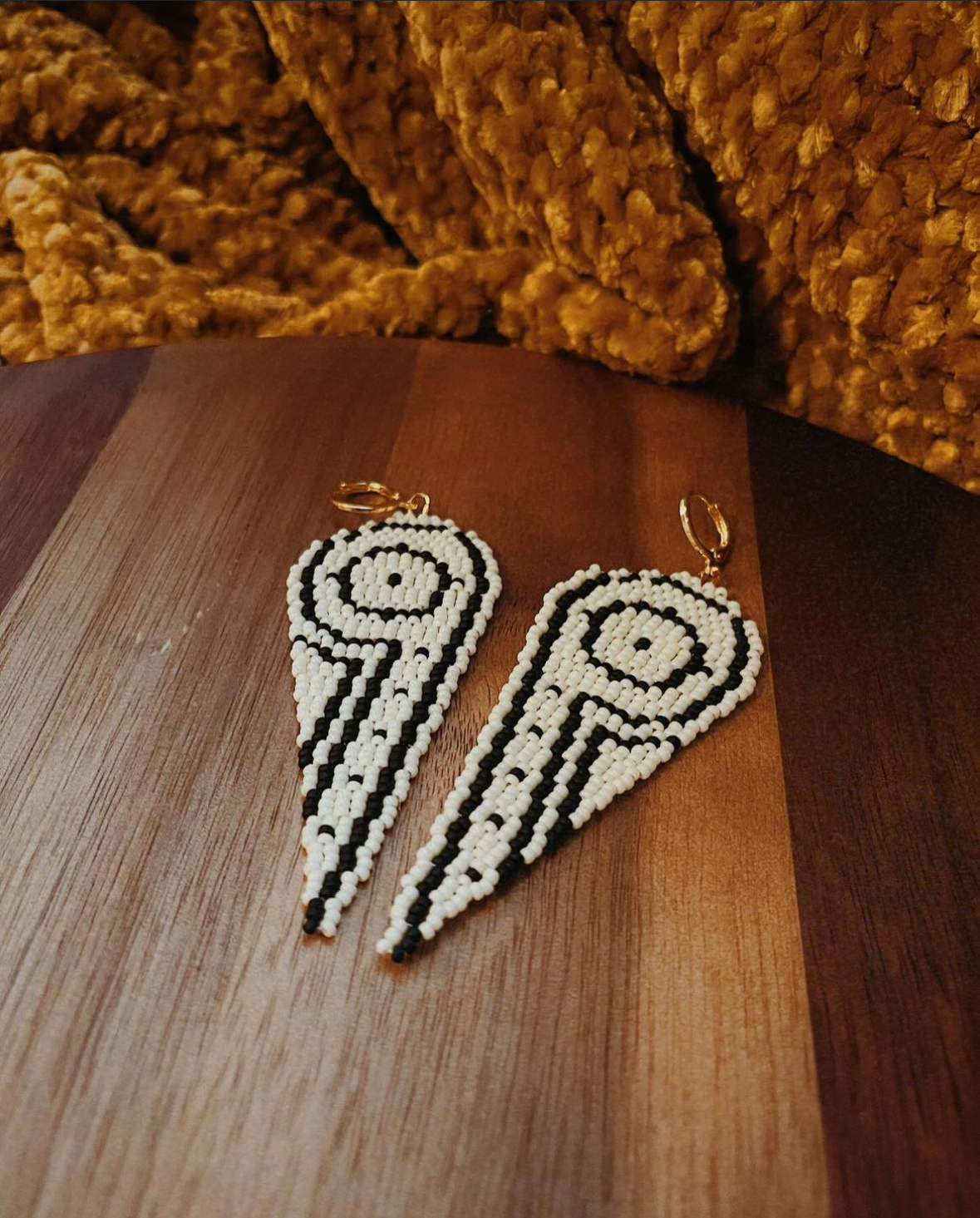For Mercedes Laadakuchax̂ (Little Doll) Kashatok, art is more than individual expression; it’s a powerful tool for community building. As Mercedes describes it, the acts of creating and sharing are inherently communal experiences that create the space necessary for healing dialogues, connection, and understanding.
“Art is a great tool. It brings people together and helps build a capacity to be present and open important dialogues with yourself and your community.”

Mercedes’ artistic journey began as a child when, as a participant of APIA’s Urban Unangax̂ Culture Camp, they crafted their first headdress while surrounded by friends. “Beading and sewing didn’t come naturally for me,” they shared, before adding with a smile, “but the love I have for these art forms did! I just thought, ‘this is so cool! I’m having so much fun!’”
Reflecting on that pivotal experience, Mercedes adds, “Even though it took me almost three months to finish that first headdress, finally seeing it come together was really gratifying–it made all the pricked fingers and Band-Aids worth it.”

Mercedes then continued to work on several new beaded headdresses, experimenting with new methods of beading and playing with shape and form until eventually developing their own personal style. They recalled, “I had so many new ideas, and headdresses to me felt natural. I had a genuine interest in wanting to learn more about my culture.”
“…making regalia was a great gateway for me to embrace my culture.”
For Mercedes, working on and learning more about traditional regalia has served as a meditative practice that keeps them calm and grounded in their art and, in turn, with themself. “Growing up as a Native kid in the city and attending a school district that didn’t have many people who looked like me, making regalia was a great gateway for me to embrace my culture. I’m grateful for that, because it felt good to be able to find myself again,” they shared.
The pandemic marked a pivotal moment for Mercedes, reigniting their passion for beading and sewing and prompting their transition into a business owner. What started as a personal art Instagram account evolved into Chix̂tax̂ Designs—a platform for selling art, yes, but also for sharing, learning, and uplifting fellow artists. Mercedes reflects, “I just genuinely wanted to share my art and create a space for people to come together, hype up each other’s art, and have fun.”
Chix̂tax̂ Designs, Mercedes’ business identity, draws its name from the Unangam Tunuu word for rain. Mercedes explains, “I wish I had a majestic story about it, but the name ‘Chix̂tax̂’ came from when I was a kid at culture camp and we were choosing our Unangam Tunuu names. All the other kids were choosing names that meant flower, or different pretty colors – I looked outside to the pouring rain, and asked, ‘What’s the Unangam Tunuu for rain?’ Chix̂tax̂! So I held onto that name for a while so when I opened my business, Chix̂tax̂ Designs felt right – that name just fell into place.”

Operating as Chix̂tax̂ Designs, Mercedes sells their handmade earrings, necklaces, qaspeqs and other wearable garments, as well as stickers and other art prints. Mercedes’ art isn’t limited to what you see shared on their website though: “I like to try things here and there just to see how fun it can be,” they revealed. And that playful approach to art has extended Mercedes’ work to several forms, including drawing, painting, and crocheting, some of which you can view via their Instagram here.
In their time creating and sharing art, Mercedes has found both inspiration and camaraderie in the vibrant Indigenous art community on social media. “Being a good friend and a good role model is important to me, and that approach isn’t hard to come by in the online community of artists. There are just so many people in these communities that show up with good intentions to share and hype each other up.
Reflecting on the evolving landscape for Indigenous artists, Mercedes noted a significant shift in the role of social media over the past five years, stating, “Now there are so many new Indigenous content creators, actors, actresses, and models, and we finally have respectful representations of who we are in mainstream media. Now kids get to grow up seeing people who look like them and understand what it’s like to be Indigenous in the world right now—it feels very special.”

Mercedes remarked on the increased visibility and respect for Indigenous artists they have observed in mainstream media, noting that, “it’s common now to go up to someone and say, ‘Oh my gosh, I love your earrings! Who made them?’ and being able to share Indigenous-made art day-to-day helps us embrace our culture, it normalizes our visibility—we have always been here, and we have always deserved respect!”
“…creating art, beading, sewing, it is all a very slow and grounding process. So for me, it’s a way to just be with my community and connect.”
“Art and activism have a rich history of coexistence,” notes Mercedes, adding, “creating art, beading, sewing, it is all a very slow and grounding process. So for me, it’s a way to just be with my community and connect. When we talk about things that can be hard—like the state of the world—or speak about our lived experiences, art is a great tool for one to be present and depressurize, encouraging connection with yourself and others. These dialogues are so important, speaking about what you see and experience is so important, so I’m grateful we have outlets like art to help all of us in this way.”
Collaboration and community are both recurring themes throughout Mercedes’ journey as an artist. Their holistic approach embodies a philosophy of self-expression that prioritizes sharing for the sake of connection, not for recognition.
Mercedes urges creatives to steer clear of doubt and comparison, recognizing that such hindrances can impede the drive to create and share:
“As long as you’re creating for yourself and respecting those around you, you can’t go wrong—you’re already an artist, you have it in you! It doesn’t matter if you’re just beginning or even if you choose not to share your art publicly, you’re still an artist.”
